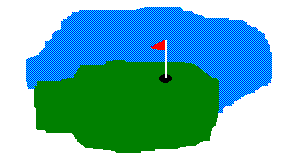

Hypothesis: The Hypothesis of this experiment is that one of three alterations to a golf ball will result in improved distance. The three methods include increased mass, change in outside aerodynamics, and the third is by adding increased propellants. Though the modern day golf ball is a technological marvel in itself, Scientific AmeriKen hypothesizes that by making these "illegal" alterations, it will give the golf ball the necessary elements to break distance records.
Equipment: For this experiment, the following is required: 3 golf balls, a driver, a large open area to perform the experiment, tape (used was scotch tape), a bottle rocket, and tools to alter the shape of the cover of the golf ball, either chisel cork screw, or other perforating device (used for this experiment was a dog).
Observations: Weather for day of the experiment
was clear, with breeze in the direction of the golf shots at about 8 m.p.h.
and temperature was about 78 degrees.
| Type of Golf Ball | Alterations | Ave. Distance Before | Ave. Distance After |
| Wilson Tc | Bottle Rocket added to exterior | 265.5 | 184.0 |
| Topflight xL | Scotch Tape added to outside to increase weight | 255.0 | 143.0 |
| Titlist Tour Balata | Cover was torn and indented by Dog | 275.0 | 134.0 |